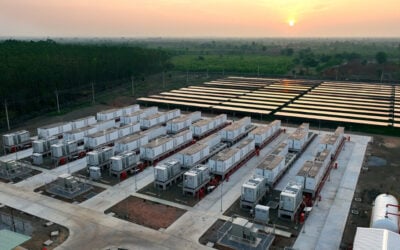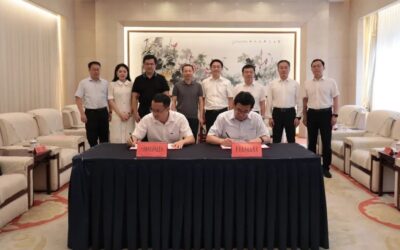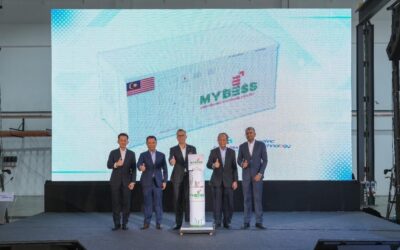The containerised ultracapacitor system is put into place. Image: Maxwell Technologies.
A large-scale system combining advanced batteries and ultracapacitor energy storage to provide utility grid services is up and running in North Carolina, according to one of the project’s partners.
Maxwell Technologies’ director of business development, Dr Kimberly McGrath, told Energy-Storage.News that the ‘hybrid ultracapacitor-battery energy storage system’ which combines multiple applications simultaneously, is an “ideal pilot” and is now operating.
Enjoy 12 months of exclusive analysis
- Regular insight and analysis of the industry’s biggest developments
- In-depth interviews with the industry’s leading figures
- Annual digital subscription to the PV Tech Power journal
- Discounts on Solar Media’s portfolio of events, in-person and virtual
The project was announced in March by utility Duke Energy, which served as ‘host utility’ for the US Energy Storage Association’s annual conference in April and has deployed several significant storage projects including the US’ largest wind farm-storage plant in Texas along with others in Ohio, North Carolina and Indiana with further investments elsewhere.
Located at Rankin Substation in Gaston County, N.C., this latest project will provide rapid response grid-balancing, solar smoothing and load shifting and extend the operational life of existing infrastructure assets. According to Duke, the need to integrate growing penetration of solar into the utility’s networks is driving the project, which the company’s technology development manager said at the time of its announcement required innovative technologies and solutions.
“The Duke Energy hybrid ultracapacitor-battery energy storage system (HESS) is operating and will demonstrate multiple service applications: extended operational life, rapid response, real-time solar smoothing and load shifting,” Maxwell Technologies’ McGrath said, adding that Win Inertia’s software and power electronics enabled this “stacked, multi-service strategy”.
‘An ideal pilot’
The system pairs Maxwell Technologies’ ultracapacitor storage with a 100kW/300kWh Aquion Aqueous Hybrid Ion battery, the so-called ‘saltwater battery’ that promises durable deep cycling and long life as well as being non-toxic and non-combustible. In addition to this a control and energy management system from energy storage engineering and power electronics company Win Inertia “enables seamless operation” of the batteries and ultracapacitor in concert, Duke Energy said.
The ultracapacitors perform solar smoothing tasks in real-time at the distribution level, in other words compensating for clouds passing over solar PV systems or unforeseen circumstances affecting the output of solar systems. Meanwhile the batteries simultaneously shift megawatt-hours of energy from solar systems on the distribution circuits, including a 1.2MW PV array nearby.
“It’s an ideal pilot of the hybrid technology because it directly addresses milliseconds to seconds high power and fast response applications, as well as hours-long energy capacity applications. This degree of flexibility allows for multiple value streams and is customizable based on local utility needs,” McGrath added.
This article has been updated to reflect that while the project supplies both short duration balancing services, solar smoothing and load shifting, all are technically provided “in front of the meter” on the utility side of the network.






